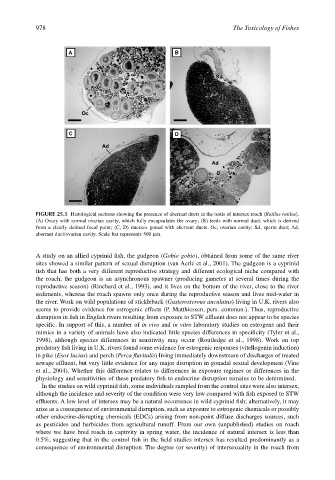Page 998 - The Toxicology of Fishes
P. 998
978 The Toxicology of Fishes
A B
C D
FIGURE 25.5 Histological sections showing the presence of aberrant ducts in the testis of intersex roach (Rutilus rutilus).
(A) Ovary with normal ovarian cavity, which fully encapsulates the ovary; (B) testis with normal duct, which is derived
from a clearly defined focal point; (C, D) intersex gonad with aberrant ducts. Oc, ovarian cavity; Sd, sperm duct; Ad,
aberrant duct/ovarian cavity. Scale bar represents 500 µm.
A study on an allied cyprinid fish, the gudgeon (Gobio gobio), obtained from some of the same river
sites showed a similar pattern of sexual disruption (van Aerle et al., 2001). The gudgeon is a cyprinid
fish that has both a very different reproductive strategy and different ecological niche compared with
the roach; the gudgeon is an asynchronous spawner (producing gametes at several times during the
reproductive season) (Rinchard et al., 1993), and it lives on the bottom of the river, close to the river
sediments, whereas the roach spawns only once during the reproductive season and lives mid-water in
the river. Work on wild populations of stickleback (Gasterosterous auculatus) living in U.K. rivers also
seems to provide evidence for estrogenic effects (P. Matthiessen, pers. commun.). Thus, reproductive
disruption in fish in English rivers resulting from exposure to STW effluent does not appear to be species
specific. In support of this, a number of in vivo and in vitro laboratory studies on estrogens and their
mimics in a variety of animals have also indicated little species differences in specificity (Tyler et al.,
1998), although species differences in sensitivity may occur (Routledge et al., 1998). Work on top
predatory fish living in U.K. rivers found some evidence for estrogenic responses (vitellogenin induction)
in pike (Esox lucius) and perch (Perca fluvitalis) living immediately downstream of discharges of treated
sewage effluent, but very little evidence for any major disruption in gonadal sexual development (Vine
et al., 2004). Whether this difference relates to differences in exposure regimes or differences in the
physiology and sensitivities of these predatory fish to endocrine disruption remains to be determined.
In the studies on wild cyprinid fish, some individuals sampled from the control sites were also intersex,
although the incidence and severity of the condition were very low compared with fish exposed to STW
effluents. A low level of intersex may be a natural occurrence in wild cyprinid fish; alternatively, it may
arise as a consequence of environmental disruption, such as exposure to estrogenic chemicals or possibly
other endocrine-disrupting chemicals (EDCs) arising from non-point diffuse discharges sources, such
as pesticides and herbicides from agricultural runoff. From our own (unpublished) studies on roach
where we have bred roach in captivity in spring water, the incidence of natural intersex is less than
0.5%, suggesting that in the control fish in the field studies intersex has resulted predominantly as a
consequence of environmental disruption. The degree (or severity) of intersexuality in the roach from

